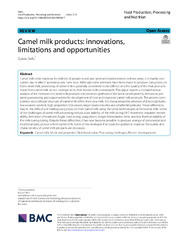| dc.contributor.author | Seifu, Eyassu | |
| dc.date.accessioned | 2023-04-17T10:30:59Z | |
| dc.date.available | 2023-04-17T10:30:59Z | |
| dc.date.issued | 2023-03-04 | |
| dc.identifier.citation | Seifu, E. (2023). Camel milk products: innovations, limitations and opportunities. Food Production, Processing and Nutrition, 5(1), 1-20. | en_US |
| dc.identifier.issn | 26618974 | |
| dc.identifier.uri | https://hdl.handle.net/13049/674 | |
| dc.identifier.uri | https://fppn.biomedcentral.com/articles/10.1186/s43014-023-00130-7 | |
| dc.description.abstract | Camel milk is the mainstay for millions of people in arid and semi-arid environments. In these areas, it is mainly consumed raw or after it spontaneously turns sour. Although some attempts have been made to produce dairy products from camel milk, processing of camel milk is generally considered to be difficult and the quality of the final products made from camel milk do not correspond to their bovine milk counterparts. This paper reports a comprehensive analysis of the literature on camel milk products and presents synthesis of the latest developments, limitations pertaining processing and opportunities for development of new and improved camel milk products. The protein composition and colloidal structure of camel milk differs from cow milk. It is characterized by absence of β-lactoglobulin, low κ-casein content, high proportion of β-casein, larger casein micelles and smaller fat globules. These differences lead to the difficulty of making dairy products from camel milk using the same technologies as for bovine milk. Some of the challenges of camel milk processing include poor stability of the milk during UHT treatment, impaired rennetability, formation of weak and fragile curd during coagulation, longer fermentation time, and low thermal stability of the milk during drying. Despite these difficulties, it has now become possible to produce a range of commercial and traditional dairy products from camel milk. Some of the strategies that could be applied to improve the quality and characteristics of camel milk products are discussed. | en_US |
| dc.language.iso | en | en_US |
| dc.publisher | BMC | en_US |
| dc.relation.ispartofseries | Food Production, Processing and Nutrition;5(1), 1-20 | |
| dc.subject | Camel milk | en_US |
| dc.subject | Medicinal properties | en_US |
| dc.subject | Nutritional value | en_US |
| dc.subject | Processing challenges | en_US |
| dc.subject | Recent developments | en_US |
| dc.title | Camel milk products: innovations, limitations and opportunities. | en_US |
| dc.type | Article | en_US |

